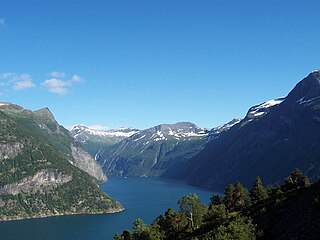
Trondheim, historically Kaupangen, Nidaros, and Trondhjem, is a city and municipality in Trøndelag county, Norway. As of 2022, it had a population of 212,660. Trondheim is the third most populous municipality in Norway, and is the fourth largest urban area. Trondheim lies on the south shore of Trondheim Fjord at the mouth of the River Nidelva. Among the significant technology-oriented institutions headquartered in Trondheim are the Norwegian University of Science and Technology (NTNU), the Foundation for Scientific and Industrial Research (SINTEF), the Geological Survey of Norway (NGU), and St. Olavs University Hospital.

Bergen, historically Bjørgvin, is a city and municipality in Vestland county on the west coast of Norway. As of 2022, its population was roughly 289,330. Bergen is the second-largest city in Norway after the national capital Oslo. The municipality covers 465 square kilometres (180 sq mi) and is on the peninsula of Bergenshalvøyen. The city centre and northern neighbourhoods are on Byfjorden, 'the city fjord'. The city is surrounded by mountains, causing Bergen to be called the "city of seven mountains". Many of the extra-municipal suburbs are on islands. Bergen is the administrative centre of Vestland county. The city consists of eight boroughs: Arna, Bergenhus, Fana, Fyllingsdalen, Laksevåg, Ytrebygda, Årstad, and Åsane.

Årstad is a borough in the city of Bergen in Vestland county, Norway. Historically, the area was a separate municipality called Årstad until 1916, when it was merged into the city of Bergen. The borough has similar boundaries to those of the old municipality.

The Norwegian Army is the land warfare service branch of the Norwegian Armed Forces. The Army is the oldest of the Norwegian service branches, established as a modern military organization under the command of the King of Norway in 1628. The Army participated in various continental wars during the 17th, 18th, and 19th centuries as well, both in Norway and abroad, especially in World War II (1939–1945). It constitutes part of the Norwegian military contribution as a charter member of the North Atlantic Treaty Organization (NATO) since 1949.

The Norwegian Armed Forces are the armed forces responsible for the defence of Norway. It consists of five branches, the Norwegian Army, the Royal Norwegian Navy, which includes the Coast Guard, the Royal Norwegian Air Force, the Home Guard, and Norwegian Cyber Defence Force as well as several joint departments.
Roald Jensen, nicknamed "Kniksen", was one of Norway's most celebrated football players. He played for SK Brann and Heart of Midlothian F.C. ("Hearts"). Knicksen is a local Bergen word meaning "juggler".

Bergen Airport, alternatively Bergen Flesland Airport or simply Flesland Airport, is an international airport located at Flesland in the city and municipality of Bergen, Vestland, Norway. Opened in 1955, it is the second-busiest airport in Norway, with 6,306,623 passengers in 2018. Flesland is operated by the state-owned Avinor. Until 1999, Flesland Air Station of the Norwegian Air Force was co-located at the airport.

Western Norway is the region along the Atlantic coast of southern Norway. It consists of the counties Rogaland, Vestland, and Møre og Romsdal. The region has no official or political-administrative function. The region has a population of approximately 1.4 million people. The largest city is Bergen and the second-largest is Stavanger. Historically the regions of Agder, Vest-Telemark, Hallingdal, Valdres, and northern parts of Gudbrandsdal have been included in Western Norway.

Bergenhus is a borough of the city of Bergen in Vestland county, Norway. This borough encompasses the city centre and is the most urbanized area of the whole city. The 25.41-square-kilometre (6,280-acre) borough has a population (2014) of 40,606. This gives Bergenhus a population density of 1,598 inhabitants per square kilometre (4,140/sq mi).

The Telemark Battalion is a mechanised infantry battalion of the Norwegian Army. It was established in 1993, and is a part of Brigade Nord and stationed at Rena, Hedmark. The battalion consists of five companies/squadrons.
This is an incomplete list of Norwegian coats of arms. Today most municipalities and all counties have their own coats of arms. Many Norwegian military units and other public agencies and some private families have coats of arms. For more general information see the page about Norwegian heraldry.
Løvstakksiden, commonly shortened to Løvstakken or simply Stakken, is a neighbourhood in the city of Bergen in Vestland county, Norway. Currently it is part of the borough of Årstad, but before 2000 it was part of a borough called "Løvstakken" which covered the eastern and western sides of the mountain Løvstakken, consisting of Fyllingsdalen in the west and Løvstakksiden in the east.

Løvstakkens Jægerkorps is a buekorps in Bergen, Norway. It is mainly the buekorps for the neighbourhood of Løvstakksiden. It was founded for the first time in 1903, then for boys only. On May 11, 1999 it was founded again as a "mixed brigade", allowing both boys and girls as members. Their current motto is: "Vennskap og samhold gir styrke".
Solheims Bataljon was a buekorps in Bergen which existed from 1927 to shortly after 1950, though some claim it was founded already in the 1890s. It is certain however, that the brigade came into existence because of the barracks which was raised after the city-fire in 1916. The boys made and took care of their rifles themselves. The working-class area in which the brigade had their headquarters was commonly called "Blodbyen".
The 2003 season of the 3. divisjon, the fourth highest association football league for men in Norway.
The 2002 season of the 3. divisjon, the fourth highest association football league for men in Norway.

Sandvikens Ungdomskorpsno:Sandvikens Ungdomskorps is an elite division amateur wind band in Bergen, Norway. The band was constituted on 1 July 1923 by a group of boys too old to play in the school band in Sandviken, Bergen. The school band is now gone, but Sandvikens Ungdomskorps has grown to be one of the leading wind bands in Norway.
Laksevågs Bueskyttere is a Buekorps in Bergen, founded 8 May 1894.

The Helge Ingstad collision was a ship collision between the Norwegian frigate Helge Ingstad and the Maltese tanker Sola TS. The accident happened on the night of 8 November 2018 in the Hjeltefjorden north of the Sture Terminal in Øygarden.














